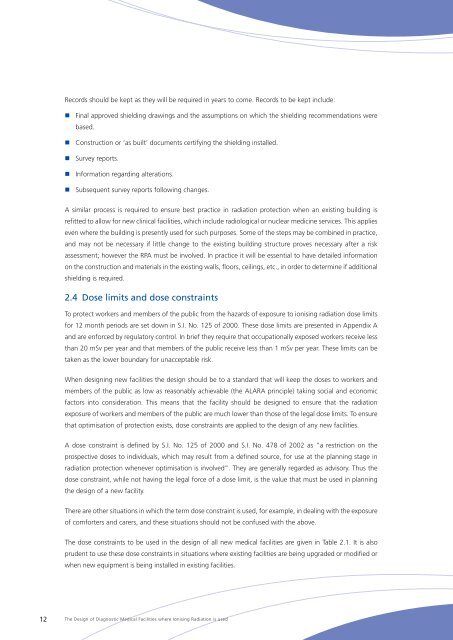The Design of Diagnostic Medical Facilities where ... - ResearchGate
The Design of Diagnostic Medical Facilities where ... - ResearchGate
The Design of Diagnostic Medical Facilities where ... - ResearchGate
You also want an ePaper? Increase the reach of your titles
YUMPU automatically turns print PDFs into web optimized ePapers that Google loves.
Records should be kept as they will be required in years to come. Records to be kept include:<br />
• Final approved shielding drawings and the assumptions on which the shielding recommendations were<br />
based.<br />
• Construction or ‘as built’ documents certifying the shielding installed.<br />
• Survey reports.<br />
• Information regarding alterations.<br />
• Subsequent survey reports following changes.<br />
A similar process is required to ensure best practice in radiation protection when an existing building is<br />
refitted to allow for new clinical facilities, which include radiological or nuclear medicine services. This applies<br />
even <strong>where</strong> the building is presently used for such purposes. Some <strong>of</strong> the steps may be combined in practice,<br />
and may not be necessary if little change to the existing building structure proves necessary after a risk<br />
assessment; however the RPA must be involved. In practice it will be essential to have detailed information<br />
on the construction and materials in the existing walls, floors, ceilings, etc., in order to determine if additional<br />
shielding is required.<br />
2.4 Dose limits and dose constraints<br />
To protect workers and members <strong>of</strong> the public from the hazards <strong>of</strong> exposure to ionising radiation dose limits<br />
for 12 month periods are set down in S.I. No. 125 <strong>of</strong> 2000. <strong>The</strong>se dose limits are presented in Appendix A<br />
and are enforced by regulatory control. In brief they require that occupationally exposed workers receive less<br />
than 20 mSv per year and that members <strong>of</strong> the public receive less than 1 mSv per year. <strong>The</strong>se limits can be<br />
taken as the lower boundary for unacceptable risk.<br />
When designing new facilities the design should be to a standard that will keep the doses to workers and<br />
members <strong>of</strong> the public as low as reasonably achievable (the ALARA principle) taking social and economic<br />
factors into consideration. This means that the facility should be designed to ensure that the radiation<br />
exposure <strong>of</strong> workers and members <strong>of</strong> the public are much lower than those <strong>of</strong> the legal dose limits. To ensure<br />
that optimisation <strong>of</strong> protection exists, dose constraints are applied to the design <strong>of</strong> any new facilities.<br />
A dose constraint is defined by S.I. No. 125 <strong>of</strong> 2000 and S.I. No. 478 <strong>of</strong> 2002 as “a restriction on the<br />
prospective doses to individuals, which may result from a defined source, for use at the planning stage in<br />
radiation protection whenever optimisation is involved”. <strong>The</strong>y are generally regarded as advisory. Thus the<br />
dose constraint, while not having the legal force <strong>of</strong> a dose limit, is the value that must be used in planning<br />
the design <strong>of</strong> a new facility.<br />
<strong>The</strong>re are other situations in which the term dose constraint is used, for example, in dealing with the exposure<br />
<strong>of</strong> comforters and carers, and these situations should not be confused with the above.<br />
<strong>The</strong> dose constraints to be used in the design <strong>of</strong> all new medical facilities are given in Table 2.1. It is also<br />
prudent to use these dose constraints in situations <strong>where</strong> existing facilities are being upgraded or modified or<br />
when new equipment is being installed in existing facilities.<br />
12<br />
<strong>The</strong> <strong>Design</strong> <strong>of</strong> <strong>Diagnostic</strong> <strong>Medical</strong> <strong>Facilities</strong> <strong>where</strong> Ionising Radiation is used
















